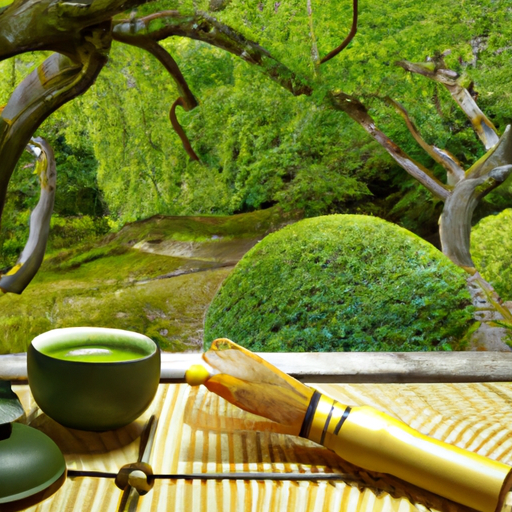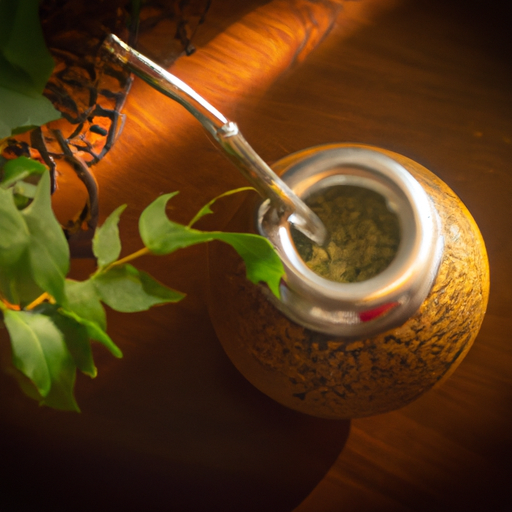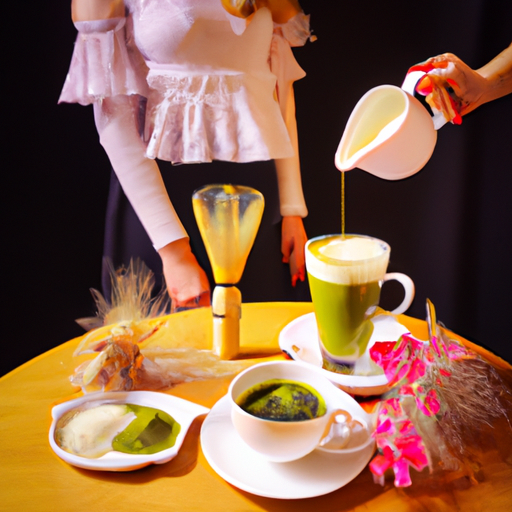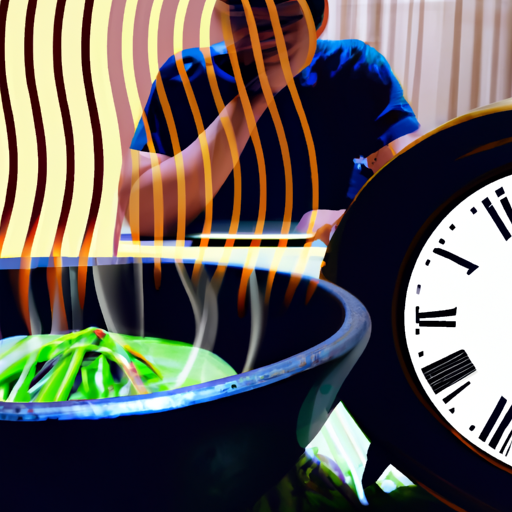As someone who regularly enjoys matcha, I’ve always been intrigued by its history. What is the origin of this brightly colored green powder, and how has it gained such global popularity as both a drink and an ingredient?
Through my research, I have discovered that matcha has a long and fascinating history, with its roots tracing back to ancient China. Matcha is a type of powdered green tea that has been consumed in Japan for centuries, and is now enjoyed globally for its unique flavor and numerous health benefits. However, many people are unaware that matcha was actually first developed in China during the Tang dynasty (618-907 AD).
It was originally used by Buddhist monks as a way to stay alert during long periods of meditation, as the tea contains high levels of caffeine and L-theanine, an amino acid that promotes relaxation and focus. Over time, matcha became popular among the Chinese nobility and eventually made its way to Japan, where it was embraced by the samurai class and eventually became a staple of traditional Japanese tea ceremonies.
Key Takeaways
- Matcha has roots tracing back to ancient China and was first developed during the Tang dynasty
- Matcha was used by Buddhist monks in China to stay alert during meditation and became popular among the Chinese nobility before making its way to Japan
- Matcha farming techniques were developed over time and involve grinding shade-grown tea leaves into a fine powder, which is then whisked with hot water
- Matcha has significant cultural significance in Japan, being used in traditional tea ceremonies, and has been consumed in Japan for centuries, with its popularity now growing around the world.
Brief History of Matcha
So, you’re probably wondering where matcha comes from and how it became so popular. Well, let me give you a brief history of this delicious tea.
Matcha originated in Japan and has been around for over 800 years. It was first introduced by Buddhist monks who brought back tea leaves from China and started cultivating it in Japan. Matcha farming techniques were developed over time, resulting in a unique and complex method of growing tea.
Matcha has a significant cultural significance in Japan, being used in traditional tea ceremonies. It’s also consumed on a daily basis by many Japanese people. Matcha is made by grinding shade-grown tea leaves into a fine powder, which is then whisked with hot water to create a frothy, vibrant green tea.
The unique taste, aroma, and color of matcha make it a popular choice not only in Japan but also around the world. The origin of matcha in China dates back to the Tang Dynasty (618-907 AD). However, the method of cultivating and processing tea leaves into matcha was not developed until centuries later in Japan.
The use of matcha in China declined over time, while it continued to flourish in Japan. Despite its Chinese origins, matcha is now widely regarded as a quintessential Japanese beverage.
Origin of Matcha in China
As I delve into the origin of matcha in China, I’m fascinated by the medicinal use of powdered tea that dates back to the Tang dynasty (618-907 AD). Tea was considered a valuable medicine and used for its health benefits, which eventually led to the spread of tea drinking culture throughout China and beyond.
It’s intriguing to explore how matcha, a beverage that was once used solely for its medicinal properties, has evolved into a beloved drink enjoyed for both its taste and health benefits.
Medicinal use of powdered tea
Matcha has been used for centuries in traditional Japanese medicine, and many people today still believe in its potential health benefits, such as reducing stress and improving concentration. For instance, my friend Sarah swears by drinking matcha before her morning yoga routine.
Here are some of the benefits of powdered tea that have been researched and documented:
- Matcha is high in antioxidants, which can help protect against chronic diseases like cancer and heart disease.
- It contains L-theanine, an amino acid that promotes relaxation and reduces anxiety without causing drowsiness.
- The caffeine in matcha is absorbed more slowly by the body, providing a steady stream of energy without the jitters or crash associated with coffee.
In addition to its medicinal properties, matcha also has cultural significance in Japan. The Japanese tea ceremony, or chanoyu, is a ritualized way of preparing and serving matcha that dates back hundreds of years. It is a formal art form that involves specific movements and gestures and is meant to promote mindfulness and appreciation of the present moment.
As tea drinking spread throughout Japan and beyond, different variations of the tea ceremony developed, each with its own unique style and traditions.
Spread of tea drinking culture
Tea drinking culture has spread across the world, with each country developing its own unique traditions and styles. The cultural impact of tea cannot be overstated, as it has become an integral part of various ceremonies and daily routines.
In Japan, for example, tea ceremonies have been practiced for centuries and are considered a symbol of hospitality, harmony, and tranquility. In China, tea drinking is deeply rooted in their history and has been an important part of their daily life for thousands of years. In India, chai tea is a staple beverage that is enjoyed throughout the day, often paired with snacks or meals.
The cultural significance of tea extends beyond just the act of drinking it. Tea has been used as a medium for socialization, a symbol of status, and even as a form of currency. It has brought people together and has been the catalyst for creating new friendships and relationships.
The spread of tea drinking culture has also led to the creation of various tea-related products, such as teapots, tea sets, and tea bags. It has become a global industry, with tea being exported and imported worldwide.
Matcha, a type of powdered green tea, has also become a popular beverage in many countries due to its unique flavor and health benefits. But what makes matcha different from other types of tea? Let’s explore the different types of matcha and how they are prepared.
Different Types of Matcha
As I delve deeper into the world of matcha, I’ve discovered that not all matcha is created equal. There are two main types: ceremonial grade matcha and culinary grade matcha.
Ceremonial grade matcha is known for its vibrant green color, smooth texture, and delicate flavor, making it perfect for traditional tea ceremonies.
On the other hand, culinary grade matcha is often used in cooking and baking, and has a more robust flavor profile. Understanding the differences between these two types of matcha can greatly enhance one’s appreciation for this beloved beverage.
Ceremonial grade matcha
You’re probably not surprised to learn that the highest quality grade of this vibrant green powder is used in traditional Japanese tea ceremonies. Ceremonial grade matcha is made from the youngest, most tender tea leaves, which are carefully shaded for several weeks before being hand-picked, steamed, dried, and ground into a fine powder. This labor-intensive process produces a bright green powder with a rich, vegetal flavor and a smooth, creamy texture.
Ceremonial grade matcha is known for its numerous health benefits, including its high levels of antioxidants, amino acids, and caffeine. It has been shown to improve mental alertness, boost metabolism, and enhance immune function. Additionally, it contains a unique compound called L-theanine, which promotes relaxation and reduces stress. While it is more expensive than other grades of matcha, the quality and flavor of ceremonial grade matcha make it worth the investment for those who appreciate the traditional Japanese tea ceremony or want to experience the full benefits of matcha. Moving on to the next subtopic, let’s explore culinary grade matcha and its uses in cooking and baking.
Culinary grade matcha
If you’re looking for a versatile ingredient to add a unique flavor and vibrant color to your recipes, culinary grade matcha is a great choice. This type of matcha is made from slightly older tea leaves than ceremonial grade matcha, which gives it a slightly bitter taste. However, this bitterness can be balanced out with sweet or savory ingredients, making it perfect for creative recipes.
Here are a few ways culinary grade matcha can be used in cooking:
-
Baked goods: Matcha can be added to cakes, muffins, and pastries for a unique green color and earthy flavor.
-
Smoothies and drinks: Matcha can be blended into smoothies or mixed into lattes for a boost of nutrition and energy.
-
Savory dishes: Matcha can be used as a seasoning for fish, rice, or vegetables for a unique umami flavor.
-
Desserts: Matcha can be used as a flavoring in ice cream, truffles, and other sweet treats.
Not only does culinary grade matcha add a unique flavor to dishes, it also has nutritional value. Matcha is rich in antioxidants, amino acids, and chlorophyll, which can help boost the immune system and promote overall health.
With its versatility and health benefits, culinary grade matcha is a great addition to any kitchen.
As for how matcha is produced, it begins with shading the tea plants for several weeks before harvesting the leaves. The leaves are then steamed, dried, and ground into a fine powder, which is what gives matcha its unique flavor and texture.
How Matcha is Produced
Growing and shading tea leaves, as well as harvesting and processing them, are two crucial steps in the production of matcha. To ensure the highest quality of matcha, tea leaves are grown in a shaded environment, which stimulates the production of chlorophyll and amino acids.
Once the leaves are harvested, they undergo a meticulous process of steaming, drying, and grinding. This ultimately results in the vibrant green powder that is matcha.
Growing and shading tea leaves
The art of cultivating tea leaves for matcha requires meticulous attention to detail. This includes carefully selecting the ideal shading materials and ensuring the leaves are nurtured with just the right amount of water and nutrients. Here are a few techniques used in growing and shading tea leaves for matcha:
-
Gyokuro method: This method involves shading the tea plants for 20-30 days before harvest, which reduces the amount of sunlight the leaves receive. This results in a higher concentration of chlorophyll and amino acids, contributing to the unique flavor and color of matcha.
-
Tana method: This method uses a wooden or bamboo frame to shade the tea plants. The frame is placed on top of the tea bushes and covered with black mesh or straw mats to diffuse the sunlight. This method is typically used for high-quality matcha.
-
Jikagise method: This method involves shading the tea plants with a black net for 7-10 days before harvest. This method is used to produce a milder and sweeter tasting matcha.
-
Honzu method: This method is similar to the Gyokuro method, but the shading period is shorter, typically 10-20 days. This method is used to produce matcha with a balance of umami and sweetness.
These various shading methods are essential to producing high-quality matcha. After the tea leaves have been shaded, they are harvested and processed to transform them into the vibrant green powder that’s used to make matcha tea.
Harvesting and processing tea leaves
To harvest and process tea leaves for matcha, you’ll need to carefully pluck the leaves from the shaded plants and quickly steam them to halt oxidation before they are dried and ground into a fine powder. The harvesting methods of matcha tea are crucial in maintaining the quality and flavor of the tea.
The best time to harvest the tea leaves is in early May, when the leaves are tender and have the right amount of nutrients. The leaves should be plucked by hand, selecting only the top two leaves and a bud. This ensures that the tea has the desired sweetness and flavor.
After the leaves are harvested, they are quickly steamed to stop any further oxidation. This is an important step in the tea processing techniques as it helps to preserve the color, flavor, and aroma of the tea. The steaming process can last from 20-30 seconds, depending on the type of tea.
The leaves are then dried and ground into a fine powder using traditional stone mills. This process can take several hours, but it is essential to create the smooth and delicate texture of matcha tea.
Matcha tea is not only tasty but also has many health benefits. It’s rich in antioxidants, which help to protect the body from harmful free radicals. Matcha tea also contains caffeine, which gives a natural energy boost, and L-theanine, which promotes relaxation and reduces anxiety. These health benefits make matcha tea a popular choice among health enthusiasts.
Health Benefits of Matcha
You’ll be pleased to know that sipping on a steaming cup of matcha can provide a plethora of powerful health benefits. Matcha, being a type of green tea, is packed with antioxidants, which help to reduce inflammation and prevent damage to cells caused by free radicals. These antioxidants, called catechins, are especially potent in matcha due to its preparation process, which involves grinding the entire tea leaf into a fine powder. One cup of matcha has been shown to have the same amount of antioxidants as 10 cups of regular green tea.
In addition to its antioxidant properties, matcha has also been found to have a calming effect on the mind and body. This is due to the presence of L-theanine, an amino acid that promotes relaxation and reduces stress. L-theanine also helps to enhance focus and concentration, making matcha a great choice for those looking to boost productivity without the jitters often associated with coffee.
To further illustrate the health benefits of matcha, take a look at the table below:
| Health Benefit | Description | Scientific Evidence |
|---|---|---|
| Boosts Metabolism | Matcha has been found to increase metabolism and promote fat burning | A study found that matcha increased calorie burning by 35-43% |
| Lowers Cholesterol | Matcha may help to lower LDL cholesterol levels | A study found that consuming matcha for 12 weeks reduced LDL cholesterol by 20% |
| Supports Immune System | Matcha is rich in vitamins and nutrients that support immune function | One cup of matcha contains 3 times the amount of vitamin C as an orange |
As you can see, matcha is not just a delicious drink, but also a powerhouse of health benefits. In the next section, we’ll explore the culinary uses of matcha, including some tasty recipes and preparation techniques.
Culinary Uses of Matcha
If you’re looking to expand your culinary horizons, incorporating matcha into your recipes can add a unique and flavorful twist. Matcha is a versatile ingredient that can be used in both sweet and savory recipes. Here are four ways to incorporate matcha into your cooking techniques:
-
Use matcha as a seasoning: Mix matcha powder with salt and sprinkle it on roasted vegetables or meats for a savory, umami flavor.
-
Add matcha to baked goods: Matcha can add a subtle earthy flavor to baked goods like cakes, cookies, and bread. You can also use matcha to make frosting or glaze for a sweet treat.
-
Whip up a matcha latte: Matcha powder can be used to make a delicious and creamy latte. Simply whisk matcha powder with hot water and milk, and sweeten with honey or sugar.
-
Make a matcha smoothie: Mix matcha powder with frozen fruit, yogurt, and milk for a healthy and refreshing smoothie.
Incorporating matcha into your recipes can add depth and complexity to your dishes. However, with so many matcha recipes out there, it can be overwhelming to know where to start. One popular matcha variation is the addition of milk, known as matcha latte.
Popular Matcha Variations
Indulge in the various luscious matcha variations that have gained popularity amongst connoisseurs. From matcha lattes to matcha desserts, there are many ways to enjoy this vibrant green tea powder.
Matcha lattes are a particular favorite, made by whisking matcha with hot water and steamed milk to create a creamy, indulgent drink. The earthy flavor of matcha pairs perfectly with the sweetness of the milk, making for a satisfying cup of tea.
Matcha desserts are also a popular choice, with many cafes and restaurants offering matcha-flavored cakes, cookies, and ice cream. Matcha’s unique flavor and vibrant color make it the perfect ingredient for adding a touch of elegance to any dessert. From matcha cheesecake to matcha mochi, there’s a matcha dessert out there for everyone.
As matcha continues to gain popularity around the world, it’s no surprise that more and more variations of this beloved tea are popping up. From matcha smoothies to matcha cocktails, there’s no limit to the creative ways you can incorporate matcha into your daily routine.
With its delicious taste and numerous health benefits, it’s no wonder that matcha has become a staple in kitchens and cafes around the globe.
Global Popularity of Matcha
Explore the world’s love for this vibrant green tea powder and discover why it’s become a staple in kitchens and cafes around the globe.
Matcha has been embraced by people from different parts of the world, not just for its unique taste and health benefits, but also for the versatility it offers in various recipes. From matcha lattes to matcha ice cream, the powder has become a trend in the culinary world, inspiring chefs and home cooks alike to experiment with new ways to incorporate matcha into their dishes.
Matcha’s popularity has continued to grow over the years, with more people becoming aware of its health benefits. Matcha is known to be rich in antioxidants, which help in reducing inflammation and preventing chronic diseases. This has led to an increase in demand for matcha products, which has resulted in the emergence of new matcha trends.
For example, matcha-infused skincare products have become popular, with claims of reducing inflammation and improving skin health. Matcha has also become a popular ingredient in the world of wellness, where it’s used in different ways to promote health and wellbeing. Matcha has been incorporated in smoothies, tea blends, and even in energy balls.
Its versatility in recipes has made it a favorite among health enthusiasts who are always looking for new and innovative ways to consume healthy foods. With matcha’s popularity continuing to grow, it’s clear that this vibrant green tea powder has become an important ingredient in modern cuisine, and its use is likely to continue to expand in the future.
Frequently Asked Questions
What is the difference between matcha and regular green tea?
As a tea lover, I’ve often wondered about the differences between matcha and regular green tea.
The main difference between the two is that matcha is made from shade-grown tea leaves that are ground into a fine powder, while green tea is made from whole tea leaves that are steeped in water.
Matcha also has a more intense flavor and a higher concentration of antioxidants than regular green tea. It has been shown to boost metabolism, enhance focus and concentration, and reduce stress levels.
Beyond the traditional cup, matcha can also be used in a variety of recipes such as smoothies, baked goods, and even savory dishes.
Overall, while both matcha and green tea have their own unique properties and benefits, matcha stands out for its versatility and concentrated health benefits.
How is matcha traditionally consumed in Japan?
Traditionally, matcha is consumed in Japan during tea ceremonies, which are highly ritualistic and formal events focused on the preparation and consumption of matcha.
The preparation of matcha is an intricate process that requires finely ground green tea leaves to be whisked with hot water until a frothy mixture is achieved. The resulting beverage has a distinct, earthy flavor and is often served with traditional Japanese sweets to balance the bitterness of the tea.
Matcha is also used as an ingredient in various desserts, such as mochi and ice cream, which showcase its unique flavor and vibrant green color.
While matcha has become increasingly popular in Western cultures, its origins and significance in Japanese culture remain deeply rooted in tradition and ritual.
Can matcha be grown in other parts of the world besides Japan?
It’s interesting that you ask about matcha cultivation in other parts of the world, because it speaks to the global popularity of this tea.
While matcha is traditionally associated with Japan, it can actually be grown in other regions with similar conditions. For example, there are matcha farms in China, Korea, and even the United States.
However, it’s worth noting that the quality and flavor of matcha can vary depending on where it’s grown and how it’s processed.
In Japan, matcha cultivation is a highly specialized practice that involves shading the tea plants for several weeks before harvest to increase chlorophyll production and enhance the tea’s flavor.
So while matcha can be grown elsewhere, it may not necessarily have the same depth and complexity as the Japanese variety.
What is the caffeine content in matcha compared to coffee?
When comparing the caffeine content of coffee versus matcha, it’s important to note that matcha contains less caffeine than coffee. However, the caffeine in matcha is released more slowly into the body, providing a longer-lasting energy boost without the jitters or crash often associated with coffee consumption.
Additionally, matcha is packed with health benefits, including high levels of antioxidants, vitamins, and minerals, making it a much more nutritious alternative to coffee. While matcha originated in Japan, it can now be grown in other parts of the world, allowing for greater availability and accessibility to this nutrient-rich beverage.
Are there any negative side effects associated with consuming matcha regularly?
I have to admit, I’m a little obsessed with matcha. The vibrant green powder is my go-to for a morning boost, and I love the way it makes me feel focused and alert.
But, as with any substance, there are potential side effects to be aware of. Some people may experience digestive problems, such as bloating or diarrhea, after consuming matcha regularly.
Additionally, there have been some rare cases of liver damage associated with high doses of green tea extract, which is sometimes found in matcha supplements. However, it’s important to note that these cases are extremely rare and most people can safely enjoy matcha as part of a balanced diet.
As always, it’s best to consult with a healthcare professional before making any major changes to your diet or supplement routine.
Conclusion
In conclusion, learning about the origin and history of matcha was a fascinating journey. I had no idea that matcha was originally from China and was then brought over to Japan by Buddhist monks. It’s amazing how a simple tea leaf can hold so much cultural significance and have such a profound impact on people’s lives.
Furthermore, I was surprised to learn about the different types of matcha and the intricate process of producing it. From ceremonial to culinary grade, matcha offers a range of options for anyone looking to incorporate it into their diet or lifestyle. And with its numerous health benefits, it’s no wonder matcha has gained such global popularity.
In fact, I coincidentally saw a friend post on social media about a new matcha café that just opened up in my city. It seems that matcha truly is everywhere these days.
Overall, I’m grateful to have learned about this unique and cherished tea and can’t wait to try more matcha-based recipes in the future.










